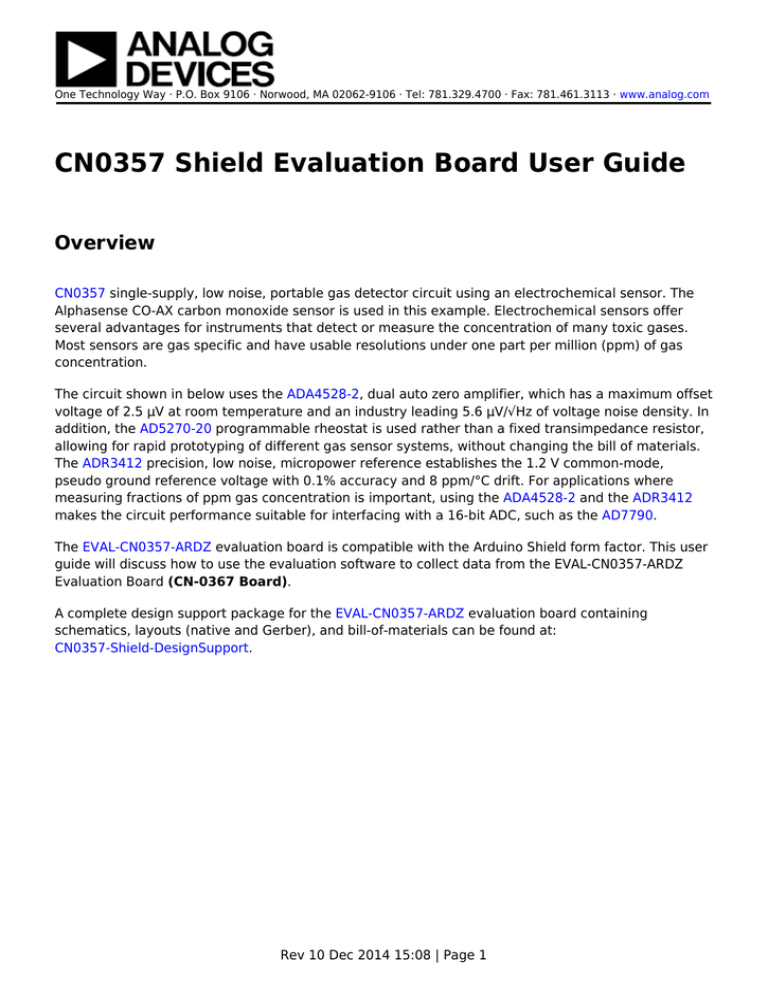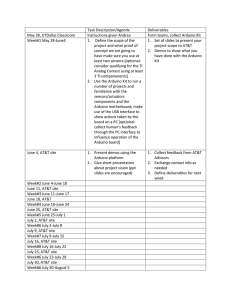
One Technology Way · P.O. Box 9106 · Norwood, MA 02062-9106 · Tel: 781.329.4700 · Fax: 781.461.3113 · www.analog.com
CN0357 Shield Evaluation Board User Guide
Overview
CN0357 single-supply, low noise, portable gas detector circuit using an electrochemical sensor. The
Alphasense CO-AX carbon monoxide sensor is used in this example. Electrochemical sensors offer
several advantages for instruments that detect or measure the concentration of many toxic gases.
Most sensors are gas specific and have usable resolutions under one part per million (ppm) of gas
concentration.
The circuit shown in below uses the ADA4528-2, dual auto zero amplifier, which has a maximum offset
voltage of 2.5 µV at room temperature and an industry leading 5.6 µV/√Hz of voltage noise density. In
addition, the AD5270-20 programmable rheostat is used rather than a fixed transimpedance resistor,
allowing for rapid prototyping of different gas sensor systems, without changing the bill of materials.
The ADR3412 precision, low noise, micropower reference establishes the 1.2 V common-mode,
pseudo ground reference voltage with 0.1% accuracy and 8 ppm/°C drift. For applications where
measuring fractions of ppm gas concentration is important, using the ADA4528-2 and the ADR3412
makes the circuit performance suitable for interfacing with a 16-bit ADC, such as the AD7790.
The EVAL-CN0357-ARDZ evaluation board is compatible with the Arduino Shield form factor. This user
guide will discuss how to use the evaluation software to collect data from the EVAL-CN0357-ARDZ
Evaluation Board (CN-0367 Board).
A complete design support package for the EVAL-CN0357-ARDZ evaluation board containing
schematics, layouts (native and Gerber), and bill-of-materials can be found at:
CN0357-Shield-DesignSupport.
Rev 10 Dec 2014 15:08 | Page 1
Required Equipment
●
●
●
●
●
EVAL-CN0357-ARDZ Evaluation Board
Arduino Processor Board (Uno/Mega 2560/Leonardo or Similar)
LINX Firmware loaded on the Arduino (only if using the software GUI)
CN0357 Shield Evaluation Software
PC with the following Minimum Requirements
Windows Vista/7 (32-bit)
USB type A Port
Processor rated at 1GHz or faster
1GB RAM and 500 MB available hard disk space
Electrochemical Gas Sensor
NOTE - Three electrode electrochemical toxic gas sensors can be used with the CN-0357 Board
The footprint can accomodate 3 different sizes of sensor.
This guide was written with the Alphasense CO-AX in mind.
❍
❍
❍
❍
●
General Setup
●
●
●
●
The EVAL-CN0357-ARDZ (CN-0357 Shield Board) connects to a Shield form factor Arduino Board
Power the system through the Arduino using an external wall wart(7V-12V recommended) for best
performance
Connect the system to the PC using a USB cable
The sensor may be connected to the M1 footprint using the appropriate pin sockets
Jumper P1 Settings
Rev 10 Dec 2014 15:08 | Page 2
●
●
“0” position - Sensor output connected to ADC(defualt)
“1” position - Sensor output connected to A1 pin of ANALOG header, for connection to external ADCs
Recommended PCB Sockets(for Alphasense Sensors)
●
●
●
A Series Sensors - Mill-Max 0364-0-15-15-13-27-10-0
B Series Sensors - Mill-Max 0294-0-15-15-06-27-10-0
D Series Sensors - Mill-Max 0667-0-15-15-30-27-10-0
Installing the Software
1. Extract the file CN0357 Eval Software.zip and open the file setup.exe.
NOTE: It is recommended that you install the CN0357 Shield Evaluation Software to the default
directory path C:\Program Files\Analog Devices\CN0357 Shield and all National Instruments
products to C:\Program Files\National Instruments\
2. Click Next to view the installation review page
Rev 10 Dec 2014 15:08 | Page 3
3. Click Next to start the installation
Rev 10 Dec 2014 15:08 | Page 4
4. Click Finish to complete the installation.
Please make sure Arduino USB drivers are installed and your Arduino processor board is flashed
with the latest LINX Firmware
Using the Evaluation Software
NOTE - The Arduino processor/controller board must use
LINX firmware to be able to connect to the Evaluation Board.
For more information, see the links found on the next portion
of thies guide.
Software Control and Indicator Descriptions
Rev 10 Dec 2014 15:08 | Page 5
Rev 10 Dec 2014 15:08 | Page 6
1. Run Button
When this button is pressed, the system will collect concentration data and present the
acquisitions in the chart.
2. Stop Button
When this button is pressed, the software stop collecting data from the CN0357 Board
3. Save Data Button
When this button is pressed, the software will save the data collected to a tab delimited ASCII
spreadsheet file.
4. Clear Data Button
When this button is pressed, the software will clear all data collected from the chart history.
5. Control Tabs
Measure Concentration - Clicking this tab brings the data collection chart to the front.
Configure System - Clicking this tab brings the system configuration settings to the front.
SDP Board Information - Clicking this tab brings the SDP Board Information to the front.
6. Concentration Numerical Indicator
This indicator displays the current concentration measured by the system.
7. Max Sensor Sensitivity Numerical Control
The maximum amount of current in nanoamps (nA) the sensor will sink/source per part per
million (ppm).
This control influences the feedback resistance set by the Rheostat (AD5270).
8. Typical Sensor Sensitivity Drop-down Menu
❍
❍
❍
❍
❍
❍
❍
❍
❍
❍
Rev 10 Dec 2014 15:08 | Page 7
❍
❍
9.
❍
10.
❍
❍
11.
❍
12.
❍
13.
❍
14.
❍
15.
❍
16.
❍
17.
❍
18.
❍
❍
19.
❍
20.
❍
21.
❍
❍
❍
22.
❍
❍
23.
The typical amount of current in nanoamps (nA) the sensor will sink/source per part per million
(ppm).
This control influences the size of the LSB in terms of ppm/mV and mV/ppm.
Sensor Range Numerical Control
The maximum concentration the sensor can measure in parts per million.
Feedback Resistance Numerical Indicator
The feedback resistance of the transimpedance amplifier on the CN0357 Board (ADA4528-2).
This can be set by the Rheostat (AD5270) or by populating a fixed resistor in the available
footprint.
ppm/mV Numerical Indicator
Parts per million concentration per millavolt
mV/ppm Numerical Indicator
millavolts per parts per million concentration
ADC Conversion Numerical Indicator
The converted voltage seen by the ADC (AD7790).
Chart Controls
These controls allow the user to zoom-in, zoom-out, and pan through the data collected.
Graph Units
This changes the units in the graph between concentration and equivalent ADC code.
System Status String Indicator
This indicator displays a message to the user detailing the current state of the software.
System Status LED Indicator
This indicator displays the current state of the software in the form of an LED. There are three
status LED colors.
Inactive
Busy
Error
Buffer Select Radio Buttons
Buffered Mode - This allows the user to place source impedance on the front end without
contributing to gain errors to the system.
Unbuffered Mode - This disables the buffers, lowering the power consumption of the device.
Enabling the buffers also reduces the Analog Input Range of the ADC
Update Rate Radio Buttons
This control allows you to select the desired output data rate of the ADC.
Software Delay
This control allows for a user configurable delay between each conversion
Reset ADC Button
Resets the ADC back to the power-on state and configures it for operation
Sets ADC back to Unbuffered mode and 9.5 Hz data rate
ADC in standby mode when not in use
Feedback Selector Radio Buttons
Rheostat - Selecting this option uses the Rheostat for the feedback resistance of the
transimpedance amplifier and disables the Fixed Resistor Numerical Control.
Fixed Resistor - Selecting this option uses a fixed-resistor for the feedback resistance of the
transimpedance amplifier and disables the RDAC Value Numerical Indicator, Rheostat
Resistance Numerical Indicator and Program Rheostat Button.
Fixed Resistor Numerical Control
Rev 10 Dec 2014 15:08 | Page 8
Input the value of the resistor populated at R8 if not using the Rheostat
24. RDAC Value Numerical Indicator
The value transmitted to the RDAC register of the Rheostat in hexadecimal format.
25. Rheostat Resistance Numerical Indicator
The equivalent resistance of the Rheostat.
26. Program Rheostat Button
Load the current RDAC value to the 50-TP Memory Block of the Digital Rheostat.
❍
❍
❍
❍
Programming the current RDAC value to 50-TP can only occur 50 times.
Programming with Arduino
The Arduino IDE is used for programming Arduino processor boards. The IDE may be downloaded from
the Official Arduino Downloads Page. Download and install the Arduino IDE to get started. Helpful
guides may also be found on the Getting Started with Arduino webpage.
Example code and library is available for the CN0357 and may be downloaded here.
To learn more about libraries and how to install them to your Arduino IDE, please visit this page.
More Information & Downloads
●
●
●
●
●
●
●
●
●
●
CN-0357 Webpage
CN-0357 Design Support Package Download - Includes Arduino Example Code
CN0357 Shield Evaluation Software
AD7790 Product Page
ADA4528-2 Product Page
ADR3412 Product Page
AD5270-20 Product Page
AD8500 Product Page
Arduino Official Website
LINX Firmware Download
© Analog Devices, Inc. All rights reserved. Trademarks and
registered trademarks are the property of their respective owners.
Rev 10 Dec 2014 15:08 | Page 9
www.analog.com

